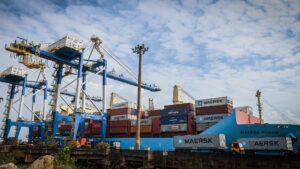
Shipping containers are the primary method of transporting cargo and are the backbone of the global trade industry and logistics. Shipping containers are large standardised metal boxes that can be stacked on top of each other and loaded onto ships and transported across oceans, borders and continents. They provide a safe, efficient, and cost effective way to transport cargo.
Shipping containers come in various shapes and sizes to accommodate different types of cargo to ensure products reach their destination safely and efficiently. In this article, we’ll explore the most common types of shipping containers, their dimensions, and the cargo types they carry.
What Are Shipping Containers?
Shipping containers are large, standardised boxes designed for transporting goods via ships, trucks, or trains. Shipping containers are highly efficient for sea freight shipment, their size and weight make them impractical for air freight. They protect cargo from the elements, secure it during transportation, and streamline loading and unloading processes.
What are Standard Shipping Containers?
A standard shipping container is a large, standardised rectangular metal box used to transport goods across different modes of transportation, such as ships, trucks, and trains . These containers are designed for durability and ease of transport, and they conform to international standards set by the International Organization for Standardization (ISO).
The most common shipping container is the 20-foot dry storage container. Its standard dimensions are:
- Length: 20 feet (6.09 metres)
- Width: 8 feet (2.44 metres)
- Height: 8.5 feet (2.59 metres)
- Weight: 2,300 kg (empty)
These containers can carry up to 30,000 kg of cargo. Another common size is the 40-foot container, which offers more space but maintains the same width and height.
Types of Shipping Containers and Their Common Uses
Here are some common types of specialised shipping containers used for cargo shipments:

1. Dry Storage Containers
Dry storage is the most common type of shipping container and is used to transport general cargo containing dry materials that doesn’t require temperature control or special handling. They can withstand all sorts of weather conditions during shipments like sea shipping. Goods like electronics, clothing, and non-perishable foods are typically shipped in these containers. Dry containers commonly come in 20ft and 40ft with many dimensions available and are completely closed on all sides.
2. Refrigerated Containers
Also known as reefers, refrigerated containers are used to transport perishable goods such as fruits, vegetables, meat, and pharmaceuticals. They are equipped with temperature control systems to maintain a stable environment for sensitive cargo to improve the shelf life of sensitive goods, especially during long-distance trips. If your goods require low temperature or refrigeration, reefers are to go for. They’re available in 20ft, 40ft, and 40ft HC.
3. Open-Top Containers
Open-top containers are ideal for oversized cargo that doesn’t fit through standard container side doors. The top is left open for easy loading with cranes, and a tarp is used to cover the cargo. Open-top containers are mostly for transporting tall goods and bulky cargos like large machinery, timber, and construction materials, the kind of cargo that doesn’t fit a regular container door. The containers come in different sizes and dimensions available in 20ft, 40ft and 40ft HC.

4. Flat Rack Containers
Flat rack containers are designed for cargo that needs loading from the side or the top. They have no sides or roof. With collapsable sides, these containers are perfect for transporting heavy, oversized, and long items like vehicles, boats, or industrial equipment.

5. Tank Containers
Tank containers, or ISO tanks, are specialised units used to transport liquids, gases, and chemicals. Built with stainless steel and surrounded by protective layers, made to withstand pressure and corrosive properties, tank containers ensure safe handling of hazardous or non-hazardous liquids such as fuel, alcohol, and food-grade liquids like oils and juices.

6. High Cube Containers
High cube containers are similar to standard containers but with an additional foot in height, making them 9.5 feet tall (30 centimetres). This extra height allows for more cargo capacity, making them useful for transporting lighter and tall goods like furniture, textiles, and voluminous consumer goods. If your items are light but can’t fit a 20ft or 40ft standard container, high cube containers are the perfect choice.
7. Insulated Containers
Insulated containers are designed to maintain a consistent temperature for sensitive goods that require protection from extreme temperatures but don’t need refrigeration. They’re used to transport cargos like medical supplies, chemicals, and certain food products to maintain their shelf life and freshness.
The choice of shipping container depends on the specific needs of the cargo. By understanding the different types of containers and their capabilities, businesses can ensure that their goods are transported safely and efficiently. It’s also important to secure your containers to prevent damage during shipment.

Importance of Using the Right Shipping Containers
It’s important to choose the right shipping container since it can directly impact the safety and efficiency of your cargo shipment. Here are the reasons why using the right shipping container matters:
1. Cargo Protection
Each type of shipping container is designed to safeguard specific types of cargo. For example, refrigerated containers maintain perishable items at the required temperature, while dry storage containers offer protection for non-perishable goods. Choosing the wrong container can lead to damage, spoilage, or contamination of your cargo, resulting in significant financial losses.
2. Compliance with Regulations
Some types of cargo, such as hazardous materials or chemicals, require specialised containers like tank containers, which comply with safety and regulatory standards. Choosing the right container ensures your shipment adheres to international shipping regulations to reduce the risk of penalties or delays during customs clearance, loading or unloading due to non-compliance or damaged cargo and ensures timely delivery.
3. Cost Efficiency
Using the right container helps reduce shipping costs. If you overestimate the container capacity or choose one with unnecessary features (e.g., refrigeration for non-perishable items), you may end up paying more for shipping. Conversely, underestimating the container requirements could lead to damage, which also incurs additional costs.
4. Streamlined Handling
The right container type simplifies loading, unloading, and transportation processes. For instance, flat rack containers make handling oversized items like vehicles or machinery more convenient, while open-top containers allow for easy loading of tall cargo. Efficient handling reduces labour and equipment costs and speeds up the entire shipping process.
Key Takeaways
In short, here’s a summary of the types of shipping containers and what they are used for:
- Dry storage containers are most commonly used for general goods like electronics and clothes.
- Refrigerated containers are ideal for transporting perishable goods like food and pharmaceuticals.
- Open-top container is best for oversized cargo like heavy machinery and construction materials.
- Flat rack is suitable for large vehicles and industrial equipment.
- Tank containers are specialised designed to handle chemicals, liquids, and hazardous substances.
- High cube container is for lightweight and tall goods.
- Insulated containers are used for temperature-sensitive goods that don’t require freezing.
Conclusion
Choosing the right container for your shipment ensures the safety, efficiency, and timeliness of your cargo delivery. Whether you’re shipping perishable food items, heavy machinery, or electronics, understanding the different types of containers will ease your shipment process.
At Global Track Lines Malaysia, we offer a wide range of shipping containers of different sizes and types that conform to ISO standards to ensure smooth and efficient shipping and to minimize delays during custom clearance. Our container lashing service will ensure your cargo is completely secured inside the shipping container during shipment. Contact us for more information on our sea freight service, we ensure that your goods reach their destination promptly and securely.




